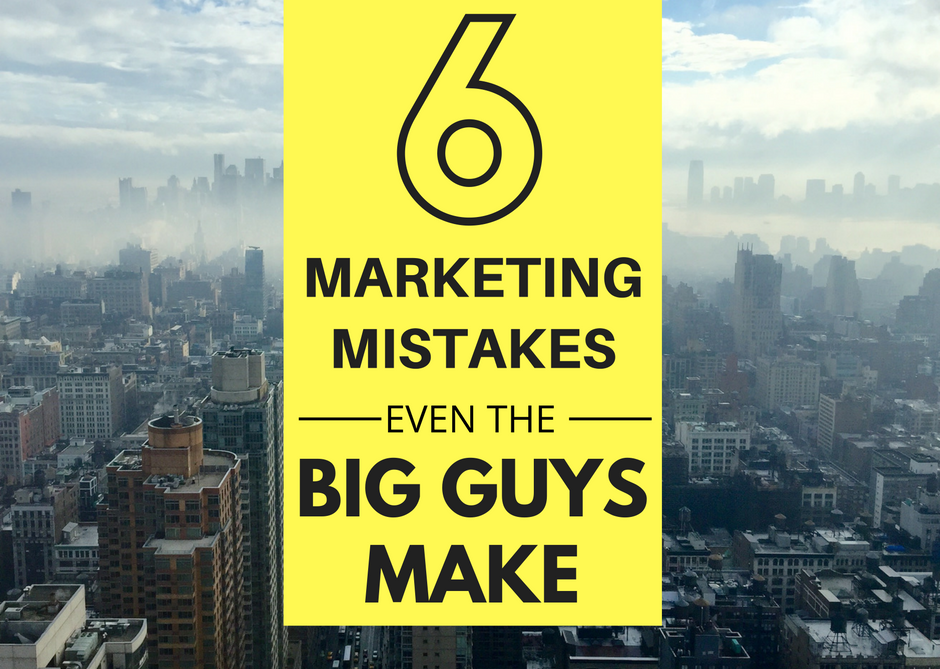Publicly traded companies are used as examples of effective business practices, but they don’t always get it right. Their big faux pas (like calling customers fat, ahem Walmart) are usually viral within a week but the some of the most growth-limiting errors they make go unnoticed, even by their own marketers.
Marketing as we know it is a relatively new idea, especially the digital aspects of modern marketing. In the short time these concepts have been around, they’ve developed rapidly, and the rate of innovation is only accelerating. To recognize a big break and seize the moment, you need to stay on top of your shhh…stuff.
Seemingly small adjustments now mean the difference between lightning fast growth and stagnation. Large companies with crowded marketing departments are often guilty of letting the details fall through the cracks, and missing the special opportunities that can skyrocket sales.
Let’s take a look at 6 marketing mistakes to watch out for
1. Falling into Routine
Google changes its search algorithm hundreds of times every year.
Larger, established companies have a habit of falling into routines. Because of their size, they can’t make company-wide changes quickly. They end up using the same systems and techniques long after their hay-day. Then, by the time they complete an update to a new system, they’re behind the curb again. New technologies are developed every day!

This is an advantage for small businesses. Your team is small; you can communicate with them directly to coordinate rapid changes. Being an innovator in your field means your product or content is going to excite and engage your audience. Study of human psychology has proven that people give attention to new concepts first, and for longer periods of time.
Large companies with constantly outdated marketing practices may grow steadily, but if their efforts aren’t optimized using the latest technologies, information, and trends, their profits won’t be maximized.
2. Staying In The Comfort Zone
Today “If it ain’t broke…” ain’t gonna work.
When the stakes are high, some marketers are too afraid to make the wrong move. Instead, they settle for a tested technique that has worked in the past. While these usually continue to deliver moderate success, they lose effectiveness over time. You’ve just wasted your chance to jump in a sports car and smoke the competition, opting for a cross-town bus ride siting next to your rivals.
Markets and audiences are constantly changing with new technologies, trends, and innovations. It’s more difficult than ever to keep your campaigns fresh and exciting.
The US consumer market is flooding with millennials. Some members of this new segment have never actually lived without a computer, literally (like “literally can’t even.”) This generation was raised in the rapidly changing digital world, and they’re not going to be slowing down the pace. It’s time to look ahead, get in the habit of constantly updating your approach. Ditch your old playbook of tried & true campaigns. Scary? Yes, but don’t forget that being an innovator in your industry means you can change the game yourself, instead of trying to follow the lead of a competitor.
3. Undefined or Generic Target Market
Your product or service is designed perfectly for someone (right? Good.) This is your ideal customer, a representation of your “Target Market.”
Target Market: A specific group of consumers at which a company aims its products and services.
All-too-often, companies try to pull in as many customers as possible with generic marketing efforts that are meant to be inclusive; you don’t want to put anyone off, so you keep your message simple (“for all your hydration needs, buy this water bottle.”) These ads introduce a product and its function, but we have no context or reasons why this product solves the consumers’ problem better than other products like it. If you leverage this message VERY well (and by that I mean spend a lot of money) giving up that margin will bring in sales, but you’re certainly not getting a lot of bang for your buck.
The higher the price tag on your product, the more convincing your message needs to be. But you can’t convert your audience to customers if you don’t know who they are, and what they need to hear. To pull in the most “ready to buy” customers, retain your desired margin, and spend the least, you need highly effective ads.
The first step is defining an ideal representative of your target market in rich detail. A useful way of doing this is writing a story for a fictional character that you believe portrays your intended clientele. These are called “Personas.”
See our example:
Design your persona: Ideal customer of a hip new briefcase company.
The demographic research shows this product is successful with male professionals between 22 and 35 who live in urban areas.
Let’s flesh out this character a bit more…
 Gender: Male
Gender: Male
Age: 28
Education: MBA
Family: Single
Geographic location: An East coast Urban center like New York City.
Occupation: Senior Project Manager
Income: $75,000 – $200,000
Interests/Hobbies: Live music, video games, Netflix, food & beverage culture, exercise, fashion, social media.
Shopping preferences: Exclusively online
Using this persona, we see we will reach our target market best by using digital ads that our persona will find relatable.
We can incorporate some of their interests such as music, food, and fashion into lifestyle imagery that speaks to them. Then using ad placement tools we get our ad in front of internet users with these traits and interests.
BOOM by creating a persona you have now placed an engaging online advertisement in front of a group of people whose interests specifically relate to your product. Doesn’t that sound nice?
Large established companies often define a persona early, but that doesn’t mean they stick to the program. After exploding in popularity, Michael Kors forgot about some the motivations of their target market. This Luxury brand experienced booming growth after their IPO in 2011, but they expanded too aggressively. The result was a supposedly high-end, exclusive, luxury product, selling everywhere. It was too accessible to keep up its reputation for exclusivity and so the bubble burst, and the moment was over with MK stock falling about 30 points in a year.
4. Niche And Non-Diversified
Remember this in B2B marketing campaigns especially. You may have a pretty specific product or service, but just because it’s niche doesn’t mean it’s a pigeon hole. Consumers can have creative uses for your product or service, so don’t assume that your campaigns should be hyper-targeted to pull in industry expert market segments only.
Let’s say you sell herbs online – don’t assume your buyers are all practitioners of herbal medicine. Powdered herbs have a variety of uses. Sure they can be used for a natural solution to sleeplessness, but a lot consumers just purchase herbs to use in the kitchen. You don’t want marketing efforts that exclusively advertise the clinical-properties of your herbs, diversify your content!
Targeting is important, but supplement your targeted campaigns with product-centric (instead of consumer-centric) content. Think about well-placed ads that attractively feature the product and it’s distinguishing qualities, rather than your ideal consumer engaging with that product. For instance, create content for your herbs that highlights their characteristics such as quality, convenience, and cost efficiency.
5. Under-Researched Approach
I once worked for a Fortune 500 company (who will remain nameless) that spent way too little time researching consumers in the market. Our campaigns basically relied on the opinion of our Sales & Marketing Manager, who assumed characteristics of market segments without ever citing real data.
I once heard that manager say not to waste resources marketing to millennials, because they simply weren’t in the market for our product. Later that same year an industry magazine published a study that revealed millennials represented the largest share of buyers…OOPS!
This is one example but errors like this can be found anytime you assume that your past experience in your industry still holds true (or assume anything really, you know what they say about assuming.)
In marketing and advertising, research is your BEST FRIEND especially for small businesses who don’t have a giant database of reports on their side. To increase your ROI you need to be researching how effective your campaigns are, and can be.
- Research should be inclusive and longitudinal – start tracking all aspects of your campaigns ASAP.
- You have analytics – these tools can help you cross-reference data to find what techniques are working and where.
- Get info first-hand – find cheap or free methods to get input directly from customers. Use after-purchase surveys or online polls.
- Use A/B testing to dial in new designs and techniques.
6. Over-Commercialized Content
When I’m really into an action thriller, and all of a sudden I hear the main character say “pass me a coke” I’m immediately yanked right back into reality. (This is an actual example)
A few years ago, (think Abercrombie & Fitch in the early 2000s) having a brand plastered all over your body was stylish, but there’s been a shift away from this walking billboard lifestyle.
Because our culture is super-saturated with branding, ads, and promos, it can be easy to portray this, even accidentally, in ads or content. The problem with that is people don’t see themselves as a part of this backdrop, even though they are. Everyone sees themselves as set apart from this culture of consumerism. They see themselves as an individual, not a demographic or persona so keep this in mind. Relatable content isn’t necessarily accurate.



